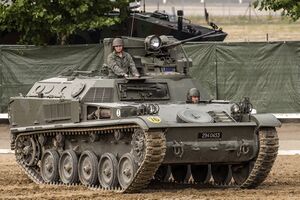Bataís APC
The Type 1951 FTA, colloquially the Bataís, is an armored personnel carrier produced by Faneria in the 1950s and early 1960s. Named for former Taesteach of the Republic Cillac Bataís, the Type 1951 was one of the first military systems produced at scale by Faneria after the Second Great War and subsequent economic downturn. As a result, the Type 1951 was used to fill a number of roles and saw an extended service life, continuing in a reserve role in the Fhainnin Army until as late as 2012. The system continues to be used in some foreign nations in its original configuration, both as an infantry transport and sometimes an armored police vehicle.
| Bataís Type 1951 FTA | |
|---|---|
 | |
| Type | Infantry Fighting Vehicle/Armored Personnel Carrier |
| Place of origin | Faneria |
| Service history | |
| In service | 1951–present |
| Wars | Archipelago War, Vandarch Canal Crisis, Final War of the Deluge |
| Production history | |
| Designed | 1942-1951 |
| Produced | 1951-1993 |
| Specifications | |
| Mass | 15.1 - 15.3 tons |
| Crew | 3 (Commander, gunner, driver) |
| Armor | 10-40 mm steel plate |
Main armament | .35" or .5" Machine Gun on pintle mount |
Secondary armament | 2x smoke cannisters |
| Engine | 250-400 hp depending on variant |
| Power/weight | 16.5 hp/t (later 25.6 hp/t) |
Operational range | 225-340 miles |
| Maximum speed |
|
Design and Production
Construction of the Type 1951 was delegated to the National Armor Plant, which subcontracted the National Arms Foundry, Madrat Motors, General Lensing, and Werthyr Steelworks for various components.
The basic outfit of the Bataís features a 7.62mm or .50 caliber machine gun and seating for three crew and ten men, though in practice, eight were seated as dismounts. Crew consist of a commander/radio operator, driver, and gunner. Optional variations in armament included a 1" autocannon or an ATGM launch system, both of which require the gunner to sit below and use a periscope or modern optics depending on the model (this must be reloaded by hand, typically with 4 or 6 total rounds in most doctrines depending on the seating of 8 or 10 dismounts). Modern variants include a counterspall lining, onboard computer, additional digital optics, and ergonomic, mechanical and engine improvements. Two engineering and two self-propelled gun variants were developed off the Bataís.
Due to its varied armament, the Type 1951 can be considered an armored personnel carrier or infantry fighting vehicle in its armed variants. Both are classed as Feithicil Troda Armúrtha (Armored Fighting Vehicle) in a Fanerian military context, with the term encompassing combat transports generally.
Variants
- Type 1951/I: Engineering variant, featuring a plow, mount for mine-launching or clearing charges, and other miscellaneous equipment.
- Type 1951/ID: Bridging engineering variant.
- Type 1951/M: IFV variant, featuring a 1" autocannon.
- Type 1951/L: ATGM variant.
- Type 1951/GD: 4" mortar carrier variant.
- Type 1951/G: 4" self-propelled gun variant.
- Type 1951/GM: 6" self-propelled gun variant.
- Type 1951/86: Modernization of the basic APC chassis.
- Type 1951/86L: Modernized version with an ATGM launcher equipped.
Service History
The early portion of the Bataís' service was as the mainstay of Faneria's ground forces. Due to severe budget constraints imposed during the 1940s and 1950s to preserve the indigenous military technology sector, variants of the Type 1951 were expected to perform the majority of scout, mechanized, and even fill in gaps in the role of the tank divisions, which were at that point primarily a paper-only force. Any role not filled by a Type 1951 variant would be the responsibility of trucks sans some types of specialized recovery systems. In this role, the vehicle was tested sporadically in a pacification role in the Transisthmus and in posturing maneuvers on the Kilikas coast to respond to Caeric activity.
The debut of the Bataís on the world stage began in earnest after the development of its modernised versions after which the National Army began to divest itself of its stock of original models as quickly as possible to make room for additional newer systems, such as the Capall and Bryn, which filled the role of IFV and APC respectively. The large-scale selling of these systems saw them enter service in numerous foreign countries, including Asteria, Puertego, Tierrador, Kelekona, Pelaxia, Volonia, Calinthia, Pursat, Tapakdore, Oyashima, Kandara, Canpei, and Algoquona. Additionally, the fledgeling militaries of Caracua and Maloka recieved a number of remaining Type 1951s as military aid from Faneria in 2024-25.
Since its proliferation, variants of the Type 1951 have seen extensive use in counterinsurgency, artillery park, and engineering roles in the second and third world, particularly forming a large portion of the Asterian Defence Force artillery park and being used by riot police in Puertego and counterseparatist units in Pursat and Canpei. While long proven to be vulnerable to modern missiles and other heavy munitions, variants of the system continue service with contracts for replacement parts and occasional refits.
Gallery
-
Still from film reel, 1976.
-
1951/G 4" SPG, Teindún National Library
-
1951/I Engineering variant, National Conscription Center I3, Muir
-
1951/ID Bridging system
-
1951/GM in service with the Asterian Defence Force
-
Refurbished Puertegan 1951/M models with autocannons removed.
-
Type 1951 in use by the Pursat Counterindependence Regiment c. 2012.
-
Pursat Counterindependence Regiment c. 2014.
-
Original model on display in Cancale.